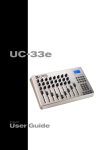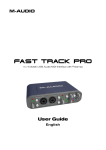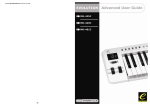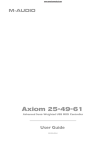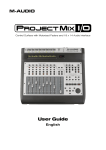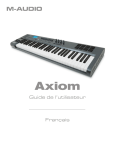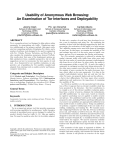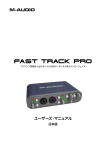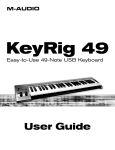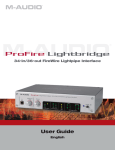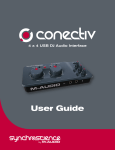Download M-Audio Evolution UC-33 User guide
Transcript
Evolution MK-425C • MK-449C • MK-461C User Guide Table of Contents Evolution Advanced Guide . About The Advanced Guide . Terminology . . . . . . . . . . Edit Mode: . . . . . . . . Default mode : . . . . . . . . . . . . . . . . . . . . . . . . . . . . . . . . . . . . . . . . . . . . . . . . . . . . . . . . . . . . . . . .4 . . . . . . . . . . . . . . . . . . . . . . . . . . . . . . . . . . . . . . . . . . . . . . . . . . . . . . . . . . . . . . .4 . . . . . . . . . . . . . . . . . . . . . . . . . . . . . . . . . . . . . . . . . . . . . . . . . . . . . . . . . . . . . . .4 . . . . . . . . . . . . . . . . . . . . . . . . . . . . . . . . . . . . . . . . . . . . . . . . . . . . . . . . . . . . . . .4 . . . . . . . . . . . . . . . . . . . . . . . . . . . . . . . . . . . . . . . . . . . . . . . . . . . . . . . . . . . . . . .4 Programming & Editing The MK-425C/449C/461C Introduction To Programming Options . . . . . . . . . Selecting A Controller For Editing . . . . . . . . . . . . Assigning MIDI CC’s . . . . . . . . . . . . . . . . . . . . Assigning An Individual MIDI Channel . . . . . . . . . . Setting Toggle Values For The Buttons . . . . . . . . . . RPN/NRPN, GM 1+2 SysEx & Other Messages . . . . Assigning MMC Control To A Button . . . . . . . . . . Assigning RPN/NRPN To A Fader/Rotary Controller Assigning A Note To A Button . . . . . . . . . . . . . . About SysEx Messages & Device ID . . . . . . . . . . . Non-Volatile Memory . . . . . . . . . . . . . . . . . . . Memory Dump . . . . . . . . . . . . . . . . . . . . . . . Assigning Device ID . . . . . . . . . . . . . . . . . . . . Resetting To The Factory Default Setting . . . . . . . . MIDI Messages Explained . . . . . . . . . . . . . . . . . . . . . . . . . . . . . . . . . . . . . . .4 . . . . . . . . . . . . . . . . . . . . . . . . . . . . . . . . . . . . . . . . . . . . . . . .4 . . . . . . . . . . . . . . . . . . . . . . . . . . . . . . . . . . . . . . . . . . . . . . . .5 . . . . . . . . . . . . . . . . . . . . . . . . . . . . . . . . . . . . . . . . . . . . . . . .5 . . . . . . . . . . . . . . . . . . . . . . . . . . . . . . . . . . . . . . . . . . . . . . . .6 . . . . . . . . . . . . . . . . . . . . . . . . . . . . . . . . . . . . . . . . . . . . . . . .6 . . . . . . . . . . . . . . . . . . . . . . . . . . . . . . . . . . . . . . . . . . . . . . . .6 . . . . . . . . . . . . . . . . . . . . . . . . . . . . . . . . . . . . . . . . . . . . . . . .6 . . . . . . . . . . . . . . . . . . . . . . . . . . . . . . . . . . . . . . . . . . . . . . . .7 . . . . . . . . . . . . . . . . . . . . . . . . . . . . . . . . . . . . . . . . . . . . . . . .7 . . . . . . . . . . . . . . . . . . . . . . . . . . . . . . . . . . . . . . . . . . . . . . . .7 . . . . . . . . . . . . . . . . . . . . . . . . . . . . . . . . . . . . . . . . . . . . . . . .7 . . . . . . . . . . . . . . . . . . . . . . . . . . . . . . . . . . . . . . . . . . . . . . . .8 . . . . . . . . . . . . . . . . . . . . . . . . . . . . . . . . . . . . . . . . . . . . . . . .8 . . . . . . . . . . . . . . . . . . . . . . . . . . . . . . . . . . . . . . . . . . . . . . . .8 . . . . . . . . . . . . . . . . . . . . . . . . . . . . . . . . . . . . . . . . . . . . . . . . . . . . . . . . . .9 Program & Bank Changes Explained . . . . . . . . . . . . . . . . . . . . . . . . . . . . . . . . . . . . . . . . . . . . . . . . . . . . . . . . . . .9 RPN/NRPN’s Explained . . . . . . . . . . . . . . . . . . . . . . . . . . . . . . . . . . . . . . . . . . . . . . . . . . . . . . . . . . . . . . . . . .9 SysEx Explained . . . . . . . . . . . . . . . . . . . . . . . . . . . . . . . . . . . . . . . . . . . . . . . . . . . . . . . . . . . . . . . . . . . . . . .9 The Evolution Librarian Software . About The Evolution Librarian Software . . . Installing The Evolution Librarian Software . . Setting Up The Librarian Software . . . . . . . Librarian Overview . . . . . . . . . . . . . . . . Organising Presets Received From A Device Viewing The Contents Of A Memory . . . . . Saving A Setup . . . . . . . . . . . . . . . . . . . Loading A Setup . . . . . . . . . . . . . . . . . . Future Development Of The Librarian . . . . Technical and Warranty Info Technical Info . . . . . . . . Warranty . . . . . . . . . . . Warranty Terms . . . . Warranty Registration . . . . . . . . . . . . . . . . . . . . . . . . . . . . . . . . . . . . . . . . . . . . . . . . . . . 10 . . . . . . . . . . . . . . . . . . . . . . . . . . . . . . . . . . . . . . . . . . . . . . . . . . . . 10 . . . . . . . . . . . . . . . . . . . . . . . . . . . . . . . . . . . . . . . . . . . . . . . . . . . . 10 . . . . . . . . . . . . . . . . . . . . . . . . . . . . . . . . . . . . . . . . . . . . . . . . . . . . 10 . . . . . . . . . . . . . . . . . . . . . . . . . . . . . . . . . . . . . . . . . . . . . . . . . . . . 10 . . . . . . . . . . . . . . . . . . . . . . . . . . . . . . . . . . . . . . . . . . . . . . . . . . . . 11 . . . . . . . . . . . . . . . . . . . . . . . . . . . . . . . . . . . . . . . . . . . . . . . . . . . . 11 . . . . . . . . . . . . . . . . . . . . . . . . . . . . . . . . . . . . . . . . . . . . . . . . . . . . 11 . . . . . . . . . . . . . . . . . . . . . . . . . . . . . . . . . . . . . . . . . . . . . . . . . . . . 11 . . . . . . . . . . . . . . . . . . . . . . . . . . . . . . . . . . . . . . . . . . . . . . . . . . . . 11 . . . . . . . . . . . . . . . . . . . . . . . . . . . . . . . . . . . . . . . . . . . . . . . . . . . . . . . . 12 . . . . . . . . . . . . . . . . . . . . . . . . . . . . . . . . . . . . . . . . . . . . . . . . . . . . . . . . . . . . . . . 12 . . . . . . . . . . . . . . . . . . . . . . . . . . . . . . . . . . . . . . . . . . . . . . . . . . . . . . . . . . . . . . . 12 . . . . . . . . . . . . . . . . . . . . . . . . . . . . . . . . . . . . . . . . . . . . . . . . . . . . . . . . . . . . . . . 12 . . . . . . . . . . . . . . . . . . . . . . . . . . . . . . . . . . . . . . . . . . . . . . . . . . . . . . . . . . . . . . . 12 Contact . . . . . . . . . . . . . . . . . . . . . . . . . . . . . . . . . . . . . . . . . . . . . . . . . . . . . . . . . . . . . . . . . . . . . . . . . . 13 Appendix A –G . . . . . . . . . . . . . . . . . . . . . . . . . . . . . . . . . . . . . . . . . . . . . . . . . . . . . . . . . . . . . . . . . . . . 14 Appendix A. . . . . . . . . . . . . . . . . . . . . . . . . . . . . . . . . . . . . . . . . MIDI IMPLEMENTATION CHART . . . . . . . . . . . . . . . . . . . . . . . Appendix B - Assignable MIDI CC’s on the MK-425C/449C/461C B1 - The Faders and rotary Controllers: . . . . . . . . . . . . . . . . . . . . B2-The Buttons: . . . . . . . . . . . . . . . . . . . . . . . . . . . . . . . . . . . Appendix C - Hexadecimal Conversion Chart . . . . . . . . . . . . . . . . . . . Hexadecimal to Decimal Conversion Chart . . . . . . . . . . . . . . . . . . Appendix D - Useful MIDI data . . . . . . . . . . . . . . . . . . . . . . . . . . . . General MIDI Instruments. . . . . . . . . . . . . . . . . . . . . . . . . . . . . MIDI Note Numbers . . . . . . . . . . . . . . . . . . . . . . . . . . . . . . . . Appendix E . . . . . . . . . . . . . . . . . . . . . . . . . . . . . . . . . . . . . . . . . Standard MIDI Controller numbers (MIDI CC’s) . . . . . . . . . . . . . . . Appendix F . . . . . . . . . . . . . . . . . . . . . . . . . . . . . . . . . . . . . . . . . Roland GS and Yamaha XG NRPN Support to Roland JV/XP . . . . . . . . Appendix G . . . . . . . . . . . . . . . . . . . . . . . . . . . . . . . . . . . . . . . . General MIDI Reverb and Chorus Types . . . . . . . . . . . . . . . . . . . . . . . . . . . . . . . . . . . . . . . . . . . . . . . . . . . . 14 . . . . . . . . . . . . . . . . . . . . . . . . . . . . . . . . 14 . . . . . . . . . . . . . . . . . . . . . . . . . . . . . . . . 15 . . . . . . . . . . . . . . . . . . . . . . . . . . . . . . . . 15 . . . . . . . . . . . . . . . . . . . . . . . . . . . . . . . . 16 . . . . . . . . . . . . . . . . . . . . . . . . . . . . . . . . 17 . . . . . . . . . . . . . . . . . . . . . . . . . . . . . . . . 17 . . . . . . . . . . . . . . . . . . . . . . . . . . . . . . . . 18 . . . . . . . . . . . . . . . . . . . . . . . . . . . . . . . . 18 . . . . . . . . . . . . . . . . . . . . . . . . . . . . . . . . 18 . . . . . . . . . . . . . . . . . . . . . . . . . . . . . . . . 19 . . . . . . . . . . . . . . . . . . . . . . . . . . . . . . . . 19 . . . . . . . . . . . . . . . . . . . . . . . . . . . . . . . . 20 . . . . . . . . . . . . . . . . . . . . . . . . . . . . . . . . 20 . . . . . . . . . . . . . . . . . . . . . . . . . . . . . . . . 20 . . . . . . . . . . . . . . . . . . . . . . . . . . . . . . . . 20 1 Evolution Advanced Guide About The Advanced Guide In the MK-425C/449C/461C Advanced Guide we have made the assumption that you have been through the Getting Started Guide which should have been supplied in printed form with your keyboard. If you do not have this guide, please contact your local distributor or download it from our website www.evolution.co.uk The Getting Started Guide should insure that you are now familiar with the basic operation of the keyboard so that we now can focus on more in-depth features. First however, we need to explain some terminology we use throughout the guide. Terminology Edit Mode: Edit Mode describes the short period after a function button has been pressed during which the parameters of that function can be altered. The numeric keypad can be used to alter a parameter during this time. No data is sent out of the Evolution MK-425C/449C/ 461C when it is in Edit mode except for program and bank changes. LCD symbols shown in Edit mode will flash to show you that a particular parameter can be edited. If a number is part entered, and a new controller turned, that number will become the relevant parameter number for the new controller and the 3 second editing period will re-trigger. Default mode : Default Mode describes the state of the keyboard, when no function buttons have been pressed within the last 3 seconds. In Default mode, the LCD will show the controller symbol, and the 2 digit display will show the last selected controller. The 3 digits display the currently assigned MIDI CC number. 2 Programming & Editing The MK-425C/449C/461C Introduction To Programming Options Each of the MK-425C/449C/461C’s controllers can send MIDI cc, RPN/NRPN, GM 1&2 SysEx messages and even be assigned to individual MIDI channels. MIDI cc (continuous controller) numbers are part of the standard MIDI specifications and are typically used to control the real-time changing of parameters in musical equipment. For a complete list of standard MIDI controller numbers from 0 to 131, please see Appendix E on page 16. Any of the real-time controllers on the keyboard can be assigned to a MIDI cc number however the 10 assignable buttons have slightly different options from the 9 Faders (MK-449C/461C only) or rotary controllers. The following 2 charts show all the transmit messages you can program for each of the fader/controllers and assignable MIDI buttons respectively. We show you this already at this stage, so you can follow the principle of programming the controllers in the following instructions and examples. Please pay extra attention to the differences between how you program the faders or controllers and how you program the buttons. ASSIGN ����� ������� ��� ��� ��� ��� ��� ��� ��� ��� ��� ��� ��� ��� ��� ��� ��� ��� ��� ��� Faders & Controllers Description ������������������� ���������������������� ����������������������� ������������������ �������������������� ����������������� ������������ ��������� ������������ ���������� ������������������ ������������ �������������������� ������������������ ������������������ ������������������� ����������� ����������������� ����������� ������������������� Data Lsb (Press Twice) � � � � � � �������� �������� ��������� ��������� ������������ �������� ����������� ����������� ���������� ���������� ��������������� ������������������ ���������������� � Data Msb (Press Twice) � � � � � � �������� �������� ��������� ��������� ����������� �������� ����������� ����������� � � � � ���������������� � * Sysex messages - for details please see page 8. ** MMC Sysex messages, for details please see page 5. *** This value cannot be typed in using the numerical keypad. Type in 144 and then press the + button to set this value. 4 Evolution MK-425C • MK-449C • MK-461C Assignable MIDI Buttons ASSIGN Description ����� ������� � ������������������� ����������������������� ��� ��� ��� ��� ��� ��� ��� ��� ��� ��� ��� ��� ��� ��� ��� ��� ��� ��� ��� ��� ��� ��� ��� ��� ��� ��� ����������������������� ������������������ �������������������� ����������������� ������������ ��������� ������������ ���������� ��������������� ������������ �������������������� ������������������ ������������������ ������������������� ����������� ����������������� ����������� �������������������� ����������������� ��������������� ���������������������� ��������������� ��������������� ��������������� ��������������� ������������������� Program (Press Twice) � � � � ������ ������� ������� ������� � � � � � � � � � �������� �������� ����� ����� � � � � - Bank LSB (Press Data Msb (Press Twice) Twice) ��������������� ��������������� ��������������� ��������������� �������������������� � � �������������� � �������������� ���������������� � �������� �������� �������� �������� ��������� ��������� ��������� ��������� ����������� ������������ �������� �������� ����������� ����������� ����������� ����������� � ���������� � ���������� � ��������������� ������������������ � ���������������� ���������������� ��������� ��������� ���������������������������������������� ������������ ������������� ������������� ������������ ���������������� � � ���� � ������ � ���� - * Sysex messages - for details please see page 8. ** MMC Sysex messages, for details please see page 5. *** This value cannot be typed in using the numerical keypad. Type in 144 and then press the + button to set this value. Selecting A Controller For Editing Before you can assign a MIDI cc to one of the MK-425C/449C/461C’s controllers, you will need to select it for editing. There are 2 methods for doing this: 1. 2. Press CONTROL SELECT. The LCD will display the CONTROLLER symbol. The symbol will be flashing to indicate the controller settings can be altered.The 3-digit display will show the number of the currently selected controller, proceeded by a ‘C’, or an ‘F’ if the controller is a fader. Type in the number of the controller using the numeric keypad, or the +/- buttons. or Move a fader/rotary controller. Simply moving a fader/rotary controller will make it the currently selected controller, ready for editing. It is not possible to select any of the 10 numerical buttons by pressing them, since during edit mode, they are used to enter numerical values.To program these buttons, please use the first method. We have given the buttons 0 to 9 the following numbers for the selection process: MK-425C = 11-20, MK449C = 20-29, MK-461C = 24-33 respectively. Assigning MIDI CC’s Once the controller you want to edit has been selected, you can change the assigned MIDI cc number in the following way: 1. 2. Press “CONTROL ASSIGN”. The LCD will flash the CC symbol. The 3 digit display will indicate the currently assigned MIDI cc number. Type in a new MIDI cc value using the numeric keypad or ‘+’ and ‘-’ buttons. The MIDI controller number you select will be assigned to the currently selected controller, shown by the number on the small, 2-digit display. Example: After pressing ASSIGN, the display shows the cc symbol and in this case displays that currently the MIDI cc 07 is assigned to fader/rotary controller number 33. 5 Assigning An Individual MIDI Channel 1. 2. 3. Select the controller you want to edit as described earlier. Press “CHANNEL ASSIGN”. The LCD will display the CHAN symbol and the 3-digit display will show the current channel assignment of the selected controller, preceded by a ’c’. The small 2-digit display will show the currently selected controller for assignment. Type the MIDI channel number (01-16) you want the controller to send to, using the numeric keypad or the +/- keys. If the controller is assigned to channel 00, it will transmit on the global channel. Setting Toggle Values For The Buttons The 10 assignable buttons can each be assigned to toggle between two values.You may for instance want to send out value 15 when you first press the button followed value 74 when you press the button for a second time. This is how you do it: 1. 2. 3. 4. Press the Function button labelled “DATA MSB” 2 times. Type in 15 using the numerical keypad or the +/- keys. Press the Function button labelled “DATA LSB” 2 times. Type in 74 using the numerical keypad or the +/- keys. If you want the button to send the same value every time you press it, simply type in the same value both times. RPN/NRPN, GM 1+2 SysEx & Other Messages As already described, the standard MIDI controller numbers range from 0 to 131. We have extended the list of MIDI cc’s that can be assigned to the controllers of the keyboard to include RPN/NRPN, MMC and General MIDI 1&2 SysEx messages. These advanced messages are as easy to program as a regular MIDI cc instruction by entering values 132 to 152 when programming MIDI cc’s.The charts on page 6 (or Appendix B) show you what number correspond to each message. To program the values required for these advanced messages, the MK-425C/449C/461C requires you to press the PROGRAM, DATA LSB and DATA MSB buttons twice respectively. Pressing only once will send the program and bank change instructions “on the fly” as described in the Getting Started guide. Lets look at a couple of examples to see how this works. Please refer to the charts on pages 3 & 4 so you get to grips with the principle: Assigning MMC Control To A Button 1. 2. 3. 4. 5. 6. 7. Select the button you want to control the MMC message. Press “CONTROL ASSIGN” on the MK-425C/449C/461C. Type in “149” using the numerical keypad. This is the number that corresponds to the MMC instruction, as per the charts on pages 3 and 4. Press “CHANNEL” once. Type in “127”, using the numerical keypad. This ensures that the message is set to all device ID numbers. For more information about this, please read “About SysEx Messages & Device ID” on page 6. Press the “DATA LSB” button twice. Enter a number from the chart on the next page to select the MMC message you want: Number �� �� �� �� �� �� �� �� �� �� �� �� �� MMC Command ����� ����� �������������� ��������� ���� ��� ���� �������������� ������������ ������������� ����� ����� ����� �������������������� ���������� 6 Evolution MK-425C • MK-449C • MK-461C Assigning RPN/NRPN To A Fader/Rotary Controller Note: For a detailed description of RPN/NRPN data see section RPN/NRPN’s explained on page 8. 1. Select the desired control as described earlier. 2. Press “CONTROL ASSIGN” twice and while the display is flashing, enter controller 132 for RPN coarse, 133 for RPN fine, 134 for NRPN coarse or 135 for NRPN fine. 3. Press “DATA MSB” twice to assign the number for the RPN/NRPN MSB. 4. Press DATA LSB twice to assign the number for RPN/NRPN LSB. 5. Press “CHANNEL ASSIGN” to assign the MIDI channel the message should be sent on. You will find most data sheets for synths that make use of NRPN’s will give the MSB and LSB values that you should enter into DATA MSB and DATA LSB banks (also see Appendix F). However, some manuals may only give the hex values. The MK-425C/449C/461C requires you to enter the decimal value.You can easily convert hexadecimal values to decimal using the windows calculator. Simply select Scientific mode, select hex and enter the hexadecimal value you need to convert. Press the Dec button to convert it to a decimal value. Alternatively, use the look up table in Appendix C. Assigning A Note To A Button The following shows how to set a button to transmit a note on when pressed, and a note off when released. 1. 2. 3. 4. 5. Press “CONTROL SELECT” and press the “0” button. Press “CONTROL ASSIGN” and enter ‘147’ this is the MIDI cc number that corresponds to Note on/off mode, as shown in Appendix B. Press “DATA MSB” twice and enter a value of ‘100’. This means when you press the button, a Note on message will be sent out with a velocity of 100. Press “DATA LSB” twice, and enter a value of ‘000’.This means when you release the button, a Note off message will be sent out. Press the “PROGRAM” button twice and enter ‘064’. This will mean you are sending out MIDI note 64 or E4, each time you press the button. The MIDI note numbers are given in Appendix D. This button mode has many uses. You can play a conventional sound on the keyboard while triggering samples and effects on different MIDI channels from the buttons.You could even trigger video clips or a lighting rig. Note: When you press the button in note mode, the LCD display will briefly show the note velocity. About SysEx Messages & Device ID When transmitting SysEx messages, the individual control channel number does not define a transmit channel, but a device ID. This is made clear since when you press the CHANNEL button, the Channel symbol will not be shown and there is no ’c’ in the 3 digit display. Device ID’s range between 00 – 127. In most cases, you should set the device ID as 127. 127 means the SysEx message will be received by all devices. Please note that the device ID for a Sys Ex message assigned to a controller can not be changed using the Device ID buttons. These buttons are used for varying the global device ID of the MK-425C/449C/461C. Non-Volatile Memory The MK-425C/449C/461C uses non-volatile memory so that you can continue where you left off even after powering down and restarting. The current controller and channel assignments are stored whether you have stored your setup to a memory locations or not.Also stored is Draw Bar mode (on/off), DATA LSB and DATA MSB data, global channel setting and last used memory preset. 7 Memory Dump The dual press “MEMORY DUMP” buttons will send out a number of Sys Ex data packets that represent the 10 memories you have set up in your MK449C/461C (MK-225C: Press “DATA LSB” and “RECALL” simultaneously to send out memory dump). This is useful for storing or backing up the contents of your memory presets externally. You can record the complete memory dump in to a standard sequencer. To recall the memory dump back, play the MIDI track containing the recorded memory dump to the keyboard, making sure that the MK-425C/449C/461C’s drivers are selected as output for that particular track. The current controller assignments are not affected by a memory dump, or a memory send to the keyboard. Once a memory dump has been sent to the keyboard, you will need to recall a preset to access the new memory settings. Assigning Device ID The dual press “DEVICE ID” buttons will allow you to assign a Device ID to the MK-449C/461C (MK-225C: Press “PROGRAM and DATA MSB”). The default Device ID is 127, which means when a memory dump is performed, that dump can be received by the same keyboard model, regardless of the Device ID setting. If a device ID is assigned to any number other than 127, the memory dump performed will be specific to MK-425C/449C/461C with the same device ID. If the device ID of a MK-425C/449C/461C differs from the one recorded with the memory dump, the data will be ignored. The device ID is a handy way of differentiating between multiple keyboards. Otherwise, we recommend you keep the device ID setting as 127. When you press the Device ID buttons, you will see the small 2-digit display on LCD display ‘id’. The 3-digit display represents the assigned Device ID. You can enter a new device ID using the numeric keypad, or the ‘+’ and ‘-’ buttons. For more information on SysEx messages and device ID, please go to page 8. Resetting To The Factory Default Setting You can reset the MK-425C/449C/461C back to the factory defaults on power-up by holding down the +/- buttons. Note: Restoring the Factory presets will erase all setups stored to memory. 8 Evolution MK-425C • MK-449C • MK-461C 3 MIDI Messages Explained Program & Bank Changes Explained The original GM MIDI specification catered for only 128 voices, numbered from 0-127. It is possible to access a different voice by sending a program change. In order to expand on the GM set of voices, Bank changes were devised. Each bank contains 128 patches, that can be accessed using a program change. There are 16,384 banks available, accessible by sending a 14-bit Bank change message. The first 7 bits of this message are sent in a single byte known as the Bank LSB.The last 7 bits are specified by another byte known as the Bank MSB.The BANK LSB is the most commonly used.This allows for 128 bank changes, and often there is no need to send a Bank MSB. You will find almost all MIDI devices respond to the program change, but some that do not conform to the GM set of voices use the program change message for other purposes. Many VST instruments have adopted this approach, allowing you to use a program change to change the instrument patch. The FM7 by Native Instruments is a good example of this. Bank changes are more rarely used, although they do exist. Bank changes are useful in manufacturer’s extensions to the MIDI specification, such as Roland’s GS specification and Yamaha’s XG specification. Both of these require you to specify a Bank change, in order to access the extra voices and effects that these specifications provide. Sending Program, Bank LSB and Bank MSB data is made simple using the Mk-425C/449C/461C. Simply press the PROGRAM, DATA LSB or DATA MSB button and enter the program or bank change you wish to send. RPN/NRPN’s Explained Non-registered parameter numbers (NRPN’s) are device specific messages that enable the control of synths via MIDI. The MIDI specification defines parameter numbers to allow scope for manufacturers to specify their own controllers. The more common of these have been registered by the MIDI Manufacturer’s Association and are part of the MIDI specification (hence the term Registered Parameter Numbers – RPN’s). (See Appendix F.) MIDI controllers 98 and 99 represent the NRPN LSB and MSB respectively, while 100 and 101 represent the RPN LSB and MSB. This can be seen from the MIDI controllers list in Appendix D. To transmit an NRPN/RPN, these two controller messages are sent along with their user-specified values. A further controller message and value needs to be sent to specify the (coarse or fine) value adjustment. This is specified by controller number 6 (Data entry) for coarse adjustments or number 38 for fine adjustments. A list of NRPN’s will always be given in the User Manual of a device that receives NRPN messages. It is always necessary that the NRPN MSB and LSB are sent together. Both will be specified in the device’s manual.You may find the manufacturer’s have only specified the numbers in Hexadecimal format. In this case, use Appendix C to translate the value to Decimal. Your Evolution keyboard makes the process of transmitting NRPN’s easy. All you need is to enter the appropriate NRPN LSB by pressing the LSB/DATA button twice, enter the NRPN MSB by pressing the MSB/DATA button twice, and as you move the controller, an appropriate NRPN message will be sent out. Assign NRPN coarse to make big sweeps, or NRPN fine to make slight adjustments. SysEx Explained System Exclusive (SysEx) messages were defined in the MIDI specification to allow individual devices to have individual control via MIDI. The format of SysEx messages allows for virtually any function to be performed via MIDI – so long as the receiving device is able to translate the message, and act accordingly. This allows devices to send audio sample memory data, memory dumps, controller settings, and much more. It also allows the controllers of one device to be controlled by another. It is not possible to program your own specified SysEx message into the MK- 425C/449C/461C. However, there are some useful SysEx messages preprogrammed into the keyboard, that can be accessed by assigning the appropriate MIDI CC to a controller (see Appendix B). It should be noted that a SysEx message is not transmitted on any specified channel. All SysEx messages contain a device ID, that is used to single out devices to respond to the SysEx message. All other devices are ignored. If you are using a SysEx message on the MK-425C/449C/461C, the global channel is ignored. When you press CHANNEL, instead of entering a channel for the controller, you will be enter a device ID instead. This is indicated by the fact that the Chan symbol will not be showing. Device ID’s run from 00 to 127. 127 is the default device number setting on the MK-425C/449C/461C. This setting transmits the SysEx message to all devices. Although it is not possible to program the controllers of the MK-425C/449C/461C with your own SysEx messages, there are software applications that can receive a MIDI input signal and transmit a different, user specified message.You can program your SysEx messages into the translator software, then translate the incoming data from the keyboard to your SysEx, depending on the controller you are using. 9 4 The Evolution Librarian Software About The Evolution Librarian Software The Evolution Librarian Software is a Windows PC librarian program developed for Evolution products. The program not only works with the MK425C/449C/461C keyboards but is also compatible with the Evolution UC-33e USB controller. That means you can use one librarian package for both your keyboard and your controller, if you own a UC-33e. And even better, you can swap patches between Evolution products that’s supported by the Librarian so you never have to create the same patch twice. The librarian itself, allows you to send and receive the 10 patches to and from the MK-425C/449C/461C, load and save memory banks, view how individual patches have been programmed and drag and drop patches in order to create new combinations in the 10 memory locations. Installing The Evolution Librarian Software 1. 2. 3. Insert the Evolution Installer CD-ROM in to your CD-ROM drive. Click on “Librarian Installer” Follow the on-screen instructions to complete the installation process. Once the installation has been completed, launch the program. The following is a screenshot of what you should be seeing on your monitor. Setting Up The Librarian Software Before you start using the Librarian, check that the MK-425C/449C/461C has been selected as input and output device. 1. 2. 3. Select MIDI Setup from the Options menu. Ensure the USB driver for you MK-425C/449C/461C is selected in the “Inputs” Column. If you are using native drivers this may be named “USB Audio Device”. In the “Outputs” column, select the USB driver for you MK-425C/449C/461C If you are using native drivers this may be named “USB Audio Device”. You should now be ready to use the Librarian software with you Evolution keyboard. Librarian Overview As you can see from the screenshot of the Librarian on page 9, you can save, load, receive or send the complete content to and from either Bank columns. To transmit the complete content of your MK-425C/449C/461C to the librarian, simply press the “Receive” button on the Librarian software. This process can only be completed successfully if the USB drivers for your keyboard have been selected correctly, as described in the “Setting Up The Librarian Software” section. Once you have Received data from the keyboard, the memories are displayed in the column. 10 Evolution MK-425C • MK-449C • MK-461C Organising Presets Received From A Device You can name the memories as you like. To re-name a memory, double-click on the memory.You can then move memories around by dragging them to a new position, or using the copy buttons between the two windows. These buttons are defined below: Will copy the selected memory in Bank 2 to Bank 1. Will copy the selected memory in Bank 1 to Bank 2. Will copy all memories in Bank 2 to Bank 1. Will copy all the memories in Bank 1 to Bank 2. Will undo the last copy you made. Only the last copy is remembered. It’s a good idea to decide which column is your master column, to avoid confusion and maybe loosing hours of work. Viewing The Contents Of A Memory Right-click on a memory to view the contents. Please note that it is not possible to edit the contents of a memory. The Sys Ex librarian will simply allow you to rearrange the order of memories, or copy memories between one dump and another. The screen shot shown below shows the first memory of a memory dump from a 425C with the factory defaults. Saving A Setup Once you have named all your presets, and organised them in the desired order, click ’save’ to save the content. Alternatively you can click on the File menu and select save to save the file with the previously assigned file name, or save as to assign the memory dump a new file name. The shortcut key to save is CTRL+S. Make sure you give the file a name which allows you to quickly identify your collection of setups. Loading A Setup To load a memory setup file back in to the librarian, click on the ’Load’ button and select the required file. The loaded preset setups will appear in the Edit Window.You can then either send it directly to the Evolution device by clicking send, or edit it. Alternatively, select Open from the File menu. The shortcut key for loading is CTRL+O. Future Development Of The Librarian We strongly recommend you register your ownership of the Evolution Librarian if you would like to be kept informed about future development. As you can see from the version number, the software is at an early version 1.0 stage and we will continue to work on enhancements for the software. To register your copy, please visit www.evolution.co.uk/register 11 5 Technical and Warranty Info Technical Info Caution: The normal function of the product may be disturbed by Strong Electro Magnetic Interference. If so, simply reset the product to resume normal operation by following the instruction manual. In case the function could not resume, please use the product in other location. Note: Your M-Audio product has been tested to comply with FCC Standards FOR HOME OR OFFICE USE. Modifications not authorized by the manufacturer may void users authority to operate this device. Note:This equipment has been tested and found to comply with the limits for a Class B digital device, pursuant to Part 15 of the FCC Rules.These limits are designed to provide reasonable protection against harmful interference in a residential installation. This equipment generates, uses and can radiate radio frequency energy and, if not installed and used in accordance with the instructions, may cause harmful interference to radio communications. However, there is no guarantee that interference will not occur in a particular installation. If this equipment does cause harmful interference to radio or television reception, which can be determined by turning the equipment off and on, the user is encouraged to try to correct the interference by one or more of the following measures: < < < < Re-orient or relocate the receiving antenna. Increase the separation between the equipment and receiver. Connect the equipment to an outlet on a circuit different from that to which the receiver is connected. Consult the dealer or an experienced radio/ TV technician for help. ASIO is a trademark of Steinberg Soft– und Hardware GmbH. VST is a trademark of Steinberg Soft– und Hardware GmbH Warranty Warranty Terms M-Audio warrants products to be free from defects in materials and workmanship, under normal use and provided that the product is owned by the original, registered user. Visit www.m-audio.com/warranty for terms and limitations applying to your specific product. Warranty Registration Thank you for registering your new M-Audio product. Doing so immediately both entitles you to full warranty coverage and helps M-Audio develop and manufacture the finest quality products available. Register online at www.m-audio.com/register to receive FREE product updates. MK-425C /449C /461C Tested to comply with FCC standards FOR HOME OR STUDIO USE 12 Evolution MK-425C • MK-449C • MK-461C 6 Contact If you have any questions, comments or suggestions about this or any M-Audio product, we invite you to contact us by using the following information: M-Audio Germany Kuhallmand 34, D-74613 Ohringen, Germany M-Audio USA 5795 Martin Rd., Irwindale, CA 91706 Technical Support tel (pro products): . . . . tel (consumer products): fax (shipping): . . . . . . Sales e-mail: . . . . . . . . . . tel: . . . . . . . . . . . . fax: . . . . . . . . . . . . web: . . . . . . . . . . . . . . . . . . . . . . . . . . (626) 633-9055 . . . . . . . . . . . . . . . .(626) 633-9066 . . . . . . . . . . . . . . . .(626) 633-9032 . . . . . . . . . . . . . . . . . . . . . . . . . . . . . . . . . . . . . . . . [email protected] . . . . . . .(626) 633-9050 . . . . . . .(626) 633-9070 . http://www.m-audio.com M-Audio U.K. Floor 6, Gresham House, 53 Clarenden Road, Watford WD17 1LA, United Kingdom Technical Support e-mail: . . . . . . . tel:(Mac support): . tel: (PC support): . . Sales tel: . . . . . . . . . fax: . . . . . . . . . web: . . . . . . . . Technical Support e-mail: . . . . . . . tel . . . . . . . . . . fax: . . . . . . . . . Sales e-mail: . . . . . . . tel: . . . . . . . . . fax: . . . . . . . . . web: . . . . . . . . . . . . . . . . . . [email protected] . . . . . . . . . .+49 (0)7941 - 9870030 . . . . . . . . . . +49 (0)7941 98 70070 . . . . . . . . . . . . . . . . . . . . . . . . . . . . . . . . . . . . [email protected] . . . +49 (0)7941 98 7000 . . +49 (0)7941 98 70070 . http://www.m-audio.de M-Audio Canda 1400 St-Jean Baptiste Ave. #150, Quebec City, Quebec G2E 5B7, Canada . . . . . . . . . . . . . . [email protected] . . . . . . . . . . . . . . . . +44 (0)1765 650072 . . . . . . . . . . . . . . . . .+44 (0)1309 671301 . . . . . . . . . . . . . . . . +44 (0)1923 204010 . . . . . . . . . . . . . . . . +44 (0)1923 204039 . . . . . . . . . . . . . http://www.maudio.co.uk M-Audio France Floor 6, Gresham House, 53 Clarenden Road, Watford-WD17 1LA, Royaume-Uni Technical Support phone (PC support): . . phone (MAC support): . fax . . . . . . . . . . . Sales e-mail: . . . . . . . . . phone: . . . . . . . . . fax: . . . . . . . . . . . web: . . . . . . . . . . . . . . . . . . . . . . (418) 872-0444 . . . . . . . . . . . . (418) 872-0444 . . . . . . . . . . . : (418) 872-0034 . . . . . . . . . . . . . . . . . . . . [email protected] . . . . . . .(866) 872-0444 . . . . . . . (514) 396-7102 . . http://www.m-audio.ca M-Audio Latin America 5795 Martin Rd. Irwindale, CA 91706 USA Technical Support e-mail: . . . . . . . phone: . . . . . . . Sales e-mail: . . . . . . . phone: . . . . . . . fax: . . . . . . . . . web: . . . . . . . . Renseignements commerciaux : 0810 001 105 ou [email protected] Assistance technique : 0820 000 731 (PC) & 0820 391 191 (MAC) Assistance technique (e-mail) : [email protected] & [email protected] Fax : 01 72 72 90 52 Site web : www.m-audio.fr M-Audio Japan アビッドテクノロジー株式会社 ¦ エムオーディオ事業部 〒 460-0002 愛知県名古屋市中区丸の内 2-18-10 2-18-10 Marunouchi Naka-Ku, Nagoya 460-0002 Japan カスタマーサポート(技術的なお問い合わせ) e-mail : . . . . . . . . . . . . . . . . . . [email protected] e-mail (Macintosh 環境専用): . . . . . . [email protected] tel : . . . . . . . . . 052-218-0859(10:00 12:00 / 13:00 17:00) セールスに関するお問い合わせ (技術的なお問い合わせはご遠慮下さい) e-mail: . . . . . . . . . . . . . . . . . . . . . . . [email protected] tel: . . . . . . . . . . 052-218-3375 (9:30 12:00 / 13:00 18:00) fax: . . . . . . . . . . . . . . . . . . . . . . . . . . . 052-218-0875 プレス/ メディアに関するお問い合わせ (技術的なお問い合わせはご遠慮下さい) e-mail: . . . . . . . . . . . . . . . . . . . . . [email protected] tel: . . . . . . . . . . 052-218-3375 (9:30 12:00 / 13:00 18:00) fax: . . . . . . . . . . . . . . . . . . . . . . . . . . . 052-218-0875 web: . . . . . . . . . . . . . . . . . . . . http://www.m-audio.co.jp 13 . . . . . . . . . [email protected] . . . . . . . . . . . . (52 871) 747 90 25 . . . . . . . . . . . . . . . . . . . . . . . . . . . . . . [email protected] . . . . . . . (949) 766-7589 . . . . . . . (949) 766-7590 . http://www.m-audio.com 7 Appendix A –G Appendix A MIDI IMPLEMENTATION CHART Function ���������������� ���������������� ��������������� ���������������� ��������������� ����� ������������������ ������������������ ������������������� ���������������� ��������������� Transmitted Received ���� ���� ��������� � ���������� ����� ���������� � � � � � � � � � ����������� � � ������������������������������ ������ � � ���������������������������������������� � � ����� ���������� � ������������� ������� ����� ������� ������������������� ����������������� �������������� ������������������� � � ���������������� ������������������� � � � �������������������������������� ��������������������������� ����������������������������������� ���������������������������� � � � � � �������� ����� ������� � 14 Remarks Evolution MK-425C • MK-449C • MK-461C Appendix B - Assignable MIDI CC’s on the MK-425C/449C/461C B1 - The Faders and rotary Controllers: MIDI CC ����� Description ������������������� � Data Lsb (Press Twice) �������� ���������������������� � ��� ��� ��� ��� ��� ��� ��� ��� ��� ��� � Data Msb (Press Twice) � ����������������������� � � ������������������ � � �������������������� � � ����������������� � � ������������ �������� �������� ��������� �������� �������� ������������ ��������� ��������� ���������� ��������� ��������� ������������������ ������������ ����������� ��������������� �������� �������� ����������������������� ����������� ����������� ��������������������� ����������� ����������� ��������������������� ���������� � ���������������������� ���������� � �������������� ��������������� � �������������������� ������������������ � ��� ����������� ���������������� ���������������� ��� ������������������ � � ��� ��� ��� ��� ��� ��� * Sysex messages - for details please see page 8. ** MMC Sysex messages, for details please see page 5. *** This value cannot be typed in using the numerical keypad. Type in 144 and then press the + button to set this value. 15 B2-The Buttons: MIDI CC Description Program (Press Twice) ����� ������������������� � �������� ������������� � ��������� ����������������� � ��� ������������������ � ��� �������������������� ��� ����������������� ��� � ������������ ��� ����� ��������� ��� ����� ������������ ��� ����� ���������� ��� ����� ������������������ � ��� ��� ��������������� � ������������������� � ��� ���� ����������������� ��� � ���� ��� ���������������� � ����� ��� ����������������� � ����� �������������� ��� � �������������������� ��� ��� ��� ��� ����������� � ��������������������������� ����������������� �������� ��� ��� ��������������� ���������������������� �������������� ������������������ ������������������ ����������������� ������������������ ��� ��� ��� ��� ��� �� � � � ����� � � � � - Data Lsb Data Msb (Press Twice) (Press Twice) ��������������� ��������������� ��������������� ��������������� ��������������������� �������������� � �������������� � ���������������� � �������� �������� �������� �������� ��������� ��������� ��������� ��������� ������������ ����������� �������� �������� ����������� ����������� ����������� ����������� ���������� � ���������� � ��������������� � ������������ � ������ ���������������� ���������������� ��������� ��������� ������������� ��������������� ������ ������ ������������� ������������ ������������� ������������ ����������������� ������ � ������ � ������ � - * Sysex messages - for details please see page 8. ** MMC Sysex messages, for details please see page 5. *** This value cannot be typed in using the numerical keypad. Type in 144 and then press the + button to set this value. 16 Evolution MK-425C • MK-449C • MK-461C Appendix C - Hexadecimal Conversion Chart Hexadecimal to Decimal Conversion Chart ��������� ���������� �������� ������ ��������� ���������� �������� ������ ��������� ���������� �������� ������ � � � � � � � � � � ��� ��� �� �� ��� �� �� �� �� �� �� �� �� �� �� �� ��� ��� �� �� ��� �� �� �� �� �� �� �� �� �� �� �� ��� � � � � � � � � � � �� �� �� �� �� �� �� �� �� �� �� �� �� �� �� �� �� �� �� �� �� �� �� �� �� �� �� �� �� �� �� �� �� ��� �� �� ��� �� �� �� �� �� �� �� �� �� �� �� ��� ��� �� �� ��� �� �� �� �� �� �� �� �� �� �� �� ��� ��� �� �� ��� �� �� �� �� �� �� �� �� �� �� �� �� �� �� �� �� �� �� �� �� �� �� �� �� �� �� �� �� �� �� �� �� �� �� �� �� �� �� �� �� �� �� �� �� �� �� �� �� �� �� �� �� �� �� ��� ��� �� �� ��� �� �� �� �� �� �� �� �� �� �� �� ��� ��� �� �� ��� �� �� �� �� �� �� �� �� �� �� �� ��� ��� �� �� ��� �� �� �� �� �� �� �� �� �� �� �� �� �� �� �� ��� ��� ��� ��� ��� ��� ��� ��� ��� ��� ��� ��� ��� ��� ��� ��� ��� ��� ��� ��� ��� ��� ��� ��� ��� ��� ��� ��� 17 Appendix D - Useful MIDI data General MIDI Instruments Piano Bass Reed Synth Effects ����������������� ��������������������� ����� ������������������������ ����������������� ��������������� ��������������� �������������� �������������� Chromatic Percussion Strings/Orchestra ��������������� ������������ ������������� ���������������� �������� ���������������� ����������� ������������ ������������� ������������������� ���������������� ������������������� ������������������� ���������������� ��������������� ��������������� Pipe Ethnic ����������� ���������������� ������������� �������������� ����������� ������������� ����������������� ������������ Organ ���������� ��������� ��������� �������������� ������������������� ��������������������� ������������������� ����������� Ensemble ����������� ��������� ������������ ������������� ��������������� �������������� ����������� ����������� Synth Lead ���������� ���������� ������������� ��������� ������������ ������������� ����������� ����������� Percussive ����������������� �������������������� �������������� ���������������� �������������� ������������� ������������� ������������������� ��������������������� ��������������������� ������� ����������������� ����������������� �������������� �������������� ������������� ������������������ ������������������� ��������������������� ���������������� ������������� ��������������� ������������� ����������������������� ����� �������������������� ���������������� ���������� ���������������� �������������� ��������������� ���������������� ������������� ������������������� Synth Pad Sound Effects ����������� ������������ �������� ����������������� ��������������� ����������������� ��������������� ��������������� ������������������� ���������������� ��������������������� ����������������� ����������������� ����������������� ���������������� ����������������� ���������������������� ����������������� ������������� ��������������� ������������������� ��������������� ������������� ������������� ����������������������� ������������������������ ����������������������� ������������������� ������������������� ������������������� �������������� ����������� Guitar ������������������� ������������������� ������������������ ������������������� ������������������� ������������� ������������� ������������� Brass MIDI Note Numbers Octave Note Numbers (n) C# n Dn D# n E n F n Cn � � � � � � -1 �� �� �� �� �� �� 0 �� �� �� �� �� �� 1 �� �� �� �� �� �� 2 �� �� �� �� �� �� 3 �� �� �� �� �� �� 4 �� �� �� �� �� �� 5 �� �� �� �� �� �� 6 �� �� �� ��� ��� �� 7 ��� ��� ��� ��� ��� ��� 8 ��� ��� ��� ��� ��� ��� 9 F#n Gn G#n An A#n � � � � �� �� �� �� �� �� �� �� �� �� �� �� �� �� �� �� �� �� �� �� �� �� �� �� �� �� �� �� �� �� �� �� �� �� �� �� ��� ��� ��� ��� ��� ��� ��� ��� ��� ��� ��� ��� 18 Bn �� �� �� �� �� �� �� �� ��� ��� Evolution MK-425C • MK-449C • MK-461C Appendix E Standard MIDI Controller numbers (MIDI CC’s) 00 Bank Select 01 Modulation 02 Breath Control 03 Controller 3 04 Foot Control 05 Porta Time 06 Data Entry 07 Channel Volume 08 Balance 09 Controller 9 10 Pan 11 Expression 12 Effects Controller 1 13 Effects Controller 2 14 Controller 14 15 Controller 15 16 Gen Purpose 1 17 Gen Purpose 2 18 Gen Purpose 3 19 Gen Purpose 4 20 Controller 20 21 Controller 21 22 Controller 22 23 Controller 23 24 Controller 24 25 Controller 25 26 Controller 26 27 Controller 27 28 Controller 28 29 Controller 29 30 Controller 30 31 Controller 31 32 Bank Select LSB 33 Modulation LSB 34 Breath Control LSB 35 Controller 35 36 Foot Control LSB 37 Porta Time LSB 38 Data Entry LSB 39 Channel Volume LSB 40 Balance LSB 41 Controller 41 42 Pan LSB 43 Expression LSB 44 Controller 44 45 Controller 45 46 Controller 46 47 Controller 47 48 Gen Purpose 1 LSB 49 Gen Purpose 2 LSB 50 Gen Purpose 3 LSB 51 Gen Purpose 4 LSB 52 Controller 52 53 Controller 53 54 Controller 54 55 Controller 55 56 Controller 56 57 Controller 57 58 Controller 58 59 Controller 59 60 Controller 60 61 Controller 61 62 Controller 62 63 Controller 63 64 Sustain Pedal 65 Portamento 66 Sostenuto 67 Soft Pedal 68 Legato Pedal 69 Hold 2 70 Sound Variation 71 Resonance 72 Release Time 73 Attack Time 74 Cut-off Frequency 75 Controller 75 76 Controller 76 77 Controller 77 78 Controller 78 79 Controller 79 80 Gen Purpose 5 81 Gen Purpose 6 82 Gen Purpose 7 83 Gen Purpose 8 84 Portamento Control 85 Controller 85 86 Controller 86 87 Controller 87 88 Controller 88 89 Controller 89 90 Controller 90 91 Reverb Depth 92 Tremelo Depth 93 Chorus Depth 94 Celeste (De-tune) 95 Phaser Depth 96 Data Increment 97 Data Decrement 98 Non-Reg Param LSB 99 Non-Reg Param MSB 100 Reg Param LSB 101 Reg Param MSB 102 Controller 102 103 Controller 103 104 Controller 104 105 Controller 105 106 Controller 106 107 Controller 107 108 Controller 108 109 Controller 109 110 Controller 110 111 Controller 111 112 Controller 112 113 Controller 113 114 Controller 114 115 Controller 115 116 Controller 116 117 Controller 117 118 Controller 118 119 Controller 119 19 Channel Mode Messages 120 All Sound off 121 Reset all Controllers 122 Local Control 123 All Notes Off 124 Omni Off 125 Omni On 126 Mono On (Poly Off) 127 Poly On (Mono Off) Extra RPN Messages 128 Pitch Bend sensitivity 129 Fine Tune 130 Coarse Tune 131 Channel Pressure Appendix F Roland GS and Yamaha XG NRPN Support to Roland JV/XP NRPN MSB CC99 01 01 01 01 01 01 01 01 *14 *15 *16 *17 18 *19 1A 1C 1D 1E %1F NRPN LSB CC98 08 09 0A 20 21 63 64 66 00-7F 00-7F 00-7F 00-7F 00-7F 00-7F 00-7F 00-7F 00-7F 00-7F 00-7F Data MSB CC06 00-7F 00-7F 00-7F 00-7F 00-7F 00-7F 00-7F 00-7F 00-7F 00-7F 00-7F 00-7F 00-7F 00-7F 00-7F 00-7F 00-7F 00-7F 00-7F Data LSB CC38 n/a (-64 - 0 - +63) Vibrato Rate (relative change) n/a (-64 - 0 - +63) Vibrato Depth (relative change) n/a (-64 - 0 - +63) Vibrato Delay (relative change) n/a (-64 - 0 - +63) Filter Cutoff Freq. (relative change) n/a (-64 - 0 - +63) Filter Resonance (relative change) n/a (-64 - 0 - +63) EG (TVF&TVA) Attack Time (relative change) n/a (-64 - 0 - +63) EG (TVF&TVA) Decay Time (relative change) n/a (-64 - 0 - +63) EG (TVF&TVA) Release Time (relative change) n/a (-64 - 0 - +63) Drum Filter Cutoff Freq. (relative change) n/a (-64 - 0 - +63) Drum Filter Resonance (relative change) n/a (-64 - 0 - +63) Drum EG Attack Rate (relative change) n/a (-64 - 0 - +63) Drum EG Decay Rate (relative change) n/a (-64 - 0 - +63) Drum Instrument Pitch Coarse (relative change) n/a (-64 - 0 - +63) Drum Instrument Pitch Fine (relative change) n/a (0 to Max) Drum Instrument Level (absolute change) n/a (Random, L>C>R) Drum Instrument Panpot (absolute change) n/a (0 to Max) Drum Instrument Reverb Send Level (absolute change) n/a (0 to Max) Drum Instrument Chorus Send Level (absolute change) n/a (0 to Max) Drum Instrument Variation Send Level (absolute change) * = added by Yamaha XG; % changed from Delay to Variation by Yamaha XG Appendix G General MIDI Reverb and Chorus Types Reverb Types 0: Small Room 1: Medium Room 2: Large Room 3: Medium Hall 4: Large Hall 8: Plate Chorus Types 0: Chorus 1 1: Chorus 2 2: Chorus 3 3: Chorus 4 4: FB Chorus 5: Flanger 060123_4Series_UG_EN01 20




















